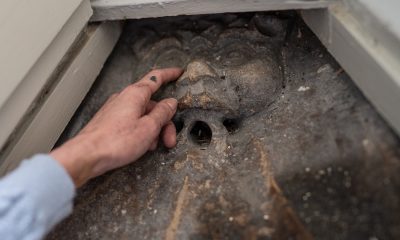Tyrannosaurus Rex that roamed Earth 68 million years ago had terrible toothache
Published
2 years ago onBy
Talker News
By Mark Waghorn via SWNS
A Tyrannosaurus Rex that roamed Earth 68 million years ago had a bone disease that would have caused terrible toothache, reveals new research.
The severe infection, known as tumefactive osteomyelitis, originated in the marrow of its left jaw.
It would have given the beast, nicknamed 'Tristan Otto', agonizing toothache - turning it into a particularly bad-tempered predator.
The creature's fossilized remains are almost complete - making it one of the best-preserved specimens ever discovered.
Now scans have identified one of the earliest known cases of a painful condition that affects humans.

Lead author Dr. Charlie Hamm, a radiologist at Charité University Hospital in Berlin, said: "On visual inspection and imaging, the left dentary showed thickening.
"A mass on the surface extended to the root of one of the teeth.
The German team used a noninvasive technique called DECT (dual-energy computed tomography).
It detected a significant accumulation of the element fluorine - a finding linked to brittle bones.
Dr Hamm said: "It supported the diagnosis of tumefactive osteomyelitis - an infection of the bone."
Privately-owned Tristan Otto was dug up in Montana in 2010. It is one of only a few T. Rex skulls with a complete set of 60 lethal dagger-like teeth.
At 13 feet tall, 40 feet long and weighing about eight tons, it was bigger than a double-decker bus.
Only about 50 T. Rex individuals have been found since the first was discovered in 1902.
Not one has been 100 percent intact. With 170 original bones out of the roughly 300 parts in the skeleton, Tristan Otto is among the best.
The researchers described T. Rex as a "familiar subject of today’s popular culture."
It was one of the largest killers to walk planet Earth. The tyrant lizard's notoriety has led to it being dubbed the 'king of the dinosaurs.'
Massive jaws unleashed a bite so strong they turned armor-plated animals into a packed lunch - chomping down with a force of over six tons.
Violent toothache would have made Tristan Otto an even angrier foe as it hunted around the present-day western US.
The imaging method has important implications in paleontology as an alternative to assessment methods that destroy fossil samples.
Dr. Hamm explained DECT deploys X-rays at two different energy levels to provide information about tissue composition and disease processes.
He said: “We hypothesized it could potentially allow for quantitative non-invasive element-based material decomposition and thereby help paleontologists in characterizing unique fossils."
The researchers were able to overcome the difficulties of scanning a large portion of Tristan Otto's lower jaw called the left dentary.
The piece’s compactness was particularly challenging as imaging quality suffers when looking at very dense objects.
Dr. Hamm said: "We needed to adjust the CT scanner's tube current and voltage in order to minimize artifacts and improve image quality."
Tristan Otto is one of only two original T. Rex skeletons in Europe. It was unearthed by a commercial paleontologist and sold to Danish investment banker Niels Nielsen in 2015.
Dr. Hamm said: "While this is a proof-of-concept study, non-invasive DECT imaging that provides structural and molecular information on unique fossil objects has the potential to address an unmet need in paleontology, avoiding defragmentation or destruction."
Tristan Otto was on display at the Natural History Museum in Berlin for four years.
Dr. Oliver Hampe, the museum's vertebrate paleontologist, said: "The DECT approach has promise in other palaeontological applications, such as age determination and differentiation of actual bone from replicas.
"The experimental design, including the use of a clinical CT scanner, will allow for broad applications."
Dr. Hamm and colleagues also collaborated with US paleontologists from to perform a CT analysis of 'Sue' - the world-famous T. Rex housed in the Field Museum in Chicago.
Dr. Hamm said: "With every project, our collaborative network grew and evolved into a truly multidisciplinary group of experts in geology, mineralogy, paleontology and radiology, emphasizing the potential and relevance of the results to different scientific fields."
Tristan Otto, named after London-based Mr. Nielsen's son, is now on display at Copenhagen University.
Mr. Nielsen has not revealed how much he paid for him. The sum will be well into seven figures.
Back in 1997, the Field Museum paid $8.3m (£6.3m) for Sue - the largest and most complete T. Rex ever found.
The NHS describes osteomyelitis as "a painful bone infection" that usually goes away if treated early with antibiotics.
It says: "If not, it can cause permanent damage. Anyone can develop osteomyelitis. Sometimes an infection in the blood affects the bone."
The study was presented at a meeting in Chicago of the Radiological Society of North America.
Stories and infographics by ‘Talker Research’ are available to download & ready to use. Stories and videos by ‘Talker News’ are managed by SWNS. To license content for editorial or commercial use and to see the full scope of SWNS content, please email [email protected] or submit an inquiry via our contact form.
You may like


Metals can heal themselves just like ‘The Terminator’


Two-faced star has hydrogen on one side and helium on other


World’s oldest big game hunting weapon found


An espresso a day could keep Alzheimer’s at bay


Being bipolar significantly raises risk of premature death: study


Soccer players who regularly use head more likely to develop Alzheimer’s
Other Stories


Touching moment brother and sister reunite after 45 years
"I didn't realize it had been so long."


Meet the 2-year-old chef obsessed with cooking shows
She started cooking when she was 11 months old alongside her mom.


Man running marathon after learning how to walk again
He was in a coma for three weeks after he suffered a fall in October 2020.


Couple find medieval gargoyle imp hiding in their bathroom
The couple took to social media for answers.


Farmer finds ‘unprecedented’ litter of 10 fox cubs
The farmer accidentally dug up their den while working.
Top Talkers

 Food & Drink1 week ago
Food & Drink1 week agoWe eat enough grilled cheeses a year to fill 900 Olympic swimming pools

 Broadcast1 week ago
Broadcast1 week agoOver 50% of Americans trust Google more than their schooling

 Parenting15 hours ago
Parenting15 hours agoSingle mom details struggles of feeding her 12 kids

 Broadcast1 week ago
Broadcast1 week agoAmericans eat enough grilled cheeses a year to fill 900 Olympic swimming pools

 Broadcast3 days ago
Broadcast3 days agoOver 40% of Americans have no clue what a 401k is

 Broadcast1 week ago
Broadcast1 week agoGrocery shopping hungry is costing Americans this much

 Funny1 week ago
Funny1 week agoCops confused by crow mimicking police siren

 Broadcast2 days ago
Broadcast2 days agoHow hard is it for Americans to live sustainably?
